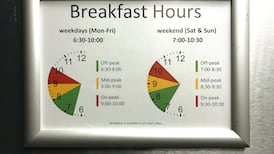Sinn Féin’s contrasting pitches to its two jurisdictions were noted at the weekend. While the First Minister-in-waiting beamed out a soothing, pluralist message at the ardfheis to her electorate in Northern Ireland, her party president hammered home an uncompromising edict to the Republic. No foot-draggers allowed. We are in “the end days of partition”, Mary Lou McDonald declared.
She may well be right. But pronouncing the end days of anything is just firing an unsettling timeline into the void. When does she envisage this end of end days to be achieved? Are we talking a year, two years, 10? And how?
The Government’s response to her giddy-up doesn’t impress her much. They are deaf to the thunder of tomorrow galloping up on them, she asserted. It must start planning for a united Ireland and it must begin by establishing a citizens’ assembly – and if it doesn’t, Sinn Féin will.
Party chairman Declan Kearney proposed a citizens’ assembly last February, “to examine constitutional change on the island of Ireland”. Important issues such as “questions about the future of the health service; the cost implications of unity; an all-island health service; future governance arrangements; taxation; pensions and public services; and the place of unionists within the new Ireland [could be discussed] in an informed environment”.
Given the progress of the Sláintecare plan in the Republic, “the future of the health service” module alone would be guaranteed to keep 99 ordinary citizens, chair and expert helpers sweatily occupied well beyond the end of days. But it’s the designation of the “the place of unionists within the new Ireland”, bringing up the rear, that may raise eyebrows. Is there much point in steaming into lengthy considerations of all-island governance without a meaningful representation of loyalists in the room?
Remember: Mary Lou McDonald wants this now.
Declan Kearney’s main reference points is the constitutional convention held between 2012 and 2014, which, he noted, “included representation from the North”. Which it did. Thirty-three of the 99 places were reserved for legislators of the Oireachtas and the Northern Ireland Assembly and each of the six political parties in the Assembly was invited to send a representative. Predictably just four accepted – Sinn Féin, the SDLP, Alliance and the Greens. The Ulster Unionists and the DUP declined.
Assemblies take their toll of everyone involved. Within the first seven months of its sittings, 24 of the original 99 members of the 2016-2018 assembly had gone
But as the precursor of the citizens’ assembly held between 2016 and 2018, the convention was a decent crack by the Fine Gael-Labour coalition at the public perception that democracy has been hollowed out by self-interested, elected institutions. And it’s worth remembering that the 2015 referendum on same-sex marriage was a recommendation of the same convention.
When the 2016-2018 assembly was first convened, the notion of a referendum on abortion seemed about as distant as Mars. And yet it was the recommendations of its 99 ordinary members serving over many weekends and without pay that flung open the door and allowed politicians to run with a proposal that became a landslide.
It’s not hard to see why Sinn Féin might find this route attractive. A citizens’ assembly provides for no political representatives so on the face of it sounds simple enough to organise and has proved capable of answering big questions.
Can it be that easy? Assemblies take their toll of everyone involved. Within the first seven months 24 of the original 99 members of the 2016-2018 assembly had gone. Seventeen never turned up, while seven dropped out at various points. All were replaced by alternates – apart from a further four who withdrew while the Eighth Amendment was being deliberated.
That’s a heavy dropout rate. Family illness, job challenges and personal difficulties took their toll as did – we can speculate – some of the complex, soul-searching issues under consideration. There are sound reasons for the protocol whereby assembly members are not identified by name and why media are asked not to photograph them.
But in the case of an assembly as envisaged by Declan Kearney, a very particular kind of patriotism, courage and soul-searching would be called upon from Northern Ireland members. There is also a view that the issues would be far too complex for such a forum. An experienced expert helper of the assembly suggests that while there might be a place for it to deliberate on some discrete and difficult issues – such as flags and anthems – these ordinary citizens would be tasked with trying to accommodate unionists in the new state. But where would the incentive be to take part in any such process unless there was a binding vote in favour?
Even if the assembly was representative of unionists (specifically the kind prepared to deliberate positively on unification issues), the complexities would be head-spinning given that every single issue in the unification question is fractal and contains beneath it another equally complex issue and so on all the way down.
It’s too easy to imagine how compromises of an profoundly complex, vague or unprincipled nature might have to be made – again by ordinary citizens. For those helping them, it would also be hugely difficult, this expert suggests, beginning with the Solomonic task of presenting the issues in a non-partisan way, where talking about possible “challenges” would be seen as obstructing unification, but doubting them would be perceived as advocating for it.
It’s a debate worth having but like every proposal under the unification banner, nothing but nothing is ever as simple as it seems. A sense of realism and a calming of those thundering hooves would be a good starting point.











